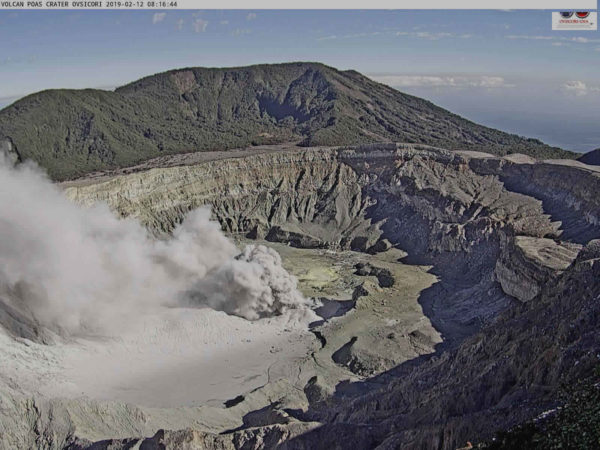– advance reservations required –
Poás Volcano is one of the major attractions in the Central Valley region (free printable PDF map of Costa Rica), one of the most visited national parks, and a great day trip add-on for any Costa Rica vacation itinerary.

Poás volcano is a powerful symbol of the geothermal forces that formed Costa Rica. When the mist and clouds part you’ll see the sulfuric, bubbling, green rain fed lake at the bottom, surrounded by smoke and steam rising from fumaroles. Water from the lake is constantly seeping through cracks in the hot rock, evaporating and building pockets of steam.
Update – August 15, 2022 – The crater viewing platform reopened to the public in August 2018 then in August of 2022 the Laguna Botos trail reopened as well. Please see this link for ticket purchase instructions (required) and further information.
When the pressure in these pockets exceeds the weight of the water above, the steam breaks through in geysers that rocket up to 820 feet (250 meters) high. Don’t worry about getting a shower though, the crater is 1,050 feet (320 meters) deep. At almost a mile (1.6 km) across it’s also the largest active crater in the world. New safety features have been added to protect visitors in case of particularly heavy activity.

A modern wheelchair accessible visitors center (currently CLOSED) and small museum explains and interprets the geothermal and ecological attractions in the park. A cafe (currently CLOSED) serves coffee and hot drinks—as much to wrap your hands around to warm them as anything else—sandwiches, and snacks.
 Poás is active, but don’t expect to see a full fledged eruption or even any lava flow here, the most recent period of violent eruptive activity ended in 1954. The last major activity was in 1910 when nearly a million tons of ash was ejected along with an immense column of smoke and steam.
Poás is active, but don’t expect to see a full fledged eruption or even any lava flow here, the most recent period of violent eruptive activity ended in 1954. The last major activity was in 1910 when nearly a million tons of ash was ejected along with an immense column of smoke and steam.
In April of 2017 an eruption of gas, ash and rocks damaged some of the buildings and trails inducing the government to close the park. The only views were from the volcanology institute live camera.

A year later improvements to the safety infrastructure including poison gas monitors, concrete bunkers, and emergency filters were initiated and at the end of August 2018 the park partially re-opened to the public. (see details and ticketing/reservation instructions).
The volcano provides an excellent if extreme example of the effects of acid rain. Around the caldera, and for several miles downwind, the vegetation is stunted brown and black by the tainted moisture that precipitates from the omnipresent clouds near the peak.
Hiking and Walking Trails
Trails that lead through cloud forest stunted and twisted, not only by volcanic emissions but the rigors of the cold windy high altitude habitat. Lake Botos fills an extinct crater at the end of one trail, and is home to many cloud forest birds including hummingbirds, tanagers, flycatchers, toucanets, Costa Rica’s national bird the clay-colored robin, and the area’s most famous avian resident, the resplendent quetzal.

The paved, level, 0.3 mile (0.5 km) crater overlook trail starts near the parking lot and takes about 10 minutes each way. Guides escort groups to the viewing area and back.
The Botos Lagoon trail (REOPENED August 2022), 0.9 miles (1.4 km) branches off the overlook trail just before the viewing platform and climbs gently to the lake. The 0.6 miles (1km) Escalonia cloud forest trail (currently CLOSED) is an excellent route to see all of the birds that live in the park, and two of the endemic species—Poás squirrels, and escalonia trees easily identified by their unique pagoda shape.
Poás is above the frost line, and temperatures below freezing are possible. Nearly constant winds and saturating humidity contribute to biting cold at the rim. When skies are clear pasty white tourists from up north can sunburn to a crisp in a matter of minutes under the tropical sun in the thin high altitude air.
When to Visit
Poás is open from 7:00 a.m. until 2:00 p.m. (last entrance at 1:20 p.m.) every day including holidays but clouds over well before noon year round and in the rainy season it may not clear off at all.
The best time to visit is always early in the morning but you can use the drop down menu to see what the weather is likely to be like in the month you’re planning to travel.
Closures
The park may close unexpectedly at any time due to volcanic activity.
Feb 14, 2019 7:00 a.m. CST – After a two day temporary closure due to ash and emission Poás Volcano National Park is open to visitors with reservations.
Two “official” facebook pages sometimes provide information on closures at Poás Volcano National Park
SINAC facebook page
PNVP facebook page
We include “travel alerts” on our facebook page and on this page when we have information about closures.

Re-scheduling or refunds are available if the park is closed due to high levels of activity (Poás Volcano refund information).
Quick Facts Poás Volcano National Park

Protecting 5,600 hectares with elevations range from 2400 to 2708 meters (7874 to 8885 feet) Poás is a small but important park. You can find cloud forest and tropical rainforest-upland habitats within the boundaries.
The story of conservation at Poás began in Tennessee’s Great Smoky Mountains National Park in the 1960’s. Mario Boza was a student when he visited the park in the United States and was so impressed that he developed a plan to manage the area around Poás Volcano in a similar way, presented it as his masters thesis, and pursued its implementation. How the plan was adopted as an integral part of the birth and development of the National Park system in Costa Rica is described in David Rains Wallace’s book, The Quetzal and the Macaw.
Poás Volcano National Park Office
Phone (506) 2482-2165 between 7 a.m. at 2 p.m. or e-mail: info.acc@sinac.go.cr
Área de Conservación Cordillera Volcánica Central (ACCVC)
Oficina Regional – Heredia, Del segundo cruce de San Miguel de Santo Domingo de Heredia 450 metros al noreste, sobre la carretera Braulio Carrillo
Teléfono: 2268-8091/ 2268-8087
Fax: 2268-8096
 Getting There
Getting There
free printable PDF map of Costa Rica
Reservations
Advance reservations (available through the park service online) are absolutely required. We have been told by several people who have tried it that if you just show up and attempt to pay at the gate you will be sent away.
Tours
Most tour operators in San José offer day trips to Poás for $US 60-140 depending on what other attractions are included (waterfalls, coffee tours, oxcart artisans, ziplines etc.). There are no accommodations in the Park.
Tours include entrance to the park so you can skip the registration and reservation procedure at SINAC
Driving Directions
From San José take the Pan American Highway west to Alajuela, across the highway from the airport. You will come into town on Calle 2. Follow this all the way through town and it becomes route 130 to Itiquis and Fraijanes and is signed for the National Park. If you are uncertain, ask before you leave Alajuela, once you are on the right road out of town it takes you directly to the park.
Alternatively, from San José take highway 3 or 5 to Heredia, then 126 north through Barva, and Roble to Varablanca where you turn left towards Poasito and follow the signs 10 km to the park.
Bus
Daily departures from Avenida2, Calles 12/14 in San José at 8:30 a.m. make one stop in Alajuela’s central plaza at 9:00 a.m. on the two hour journey to the park. There is only one return bus, don’t miss it at 2:30 p.m. (Tuasa company, $US 3, bus 1241, phone 2233-7477).
